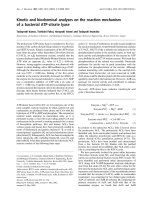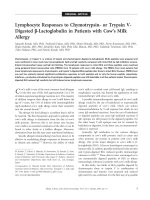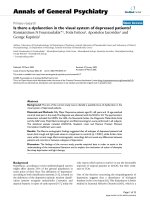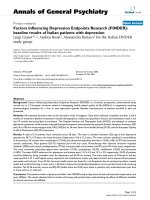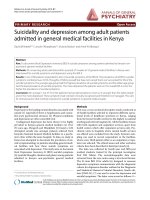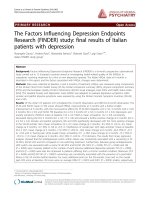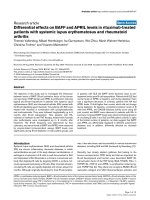Báo cáo y học: "Factors Influencing Depression Endpoints Research (FINDER): baseline results of Italian patients with depression" doc
Bạn đang xem bản rút gọn của tài liệu. Xem và tải ngay bản đầy đủ của tài liệu tại đây (407.01 KB, 9 trang )
BioMed Central
Page 1 of 9
(page number not for citation purposes)
Annals of General Psychiatry
Open Access
Primary research
Factors Influencing Depression Endpoints Research (FINDER):
baseline results of Italian patients with depression
Luigi Grassi*
1,2
, Andrea Rossi
3
, Alessandra Barraco
3
for the Italian FINDER
study group
Address:
1
Section of Psychiatry, University of Ferrara, Italy,
2
Clinical Psychiatry Unit, Department of Mental Health, NHS Health Agency, Ferrara,
Italy and
3
Medical Department, Eli Lilly Italia, Sesto Fiorentino, Italy
Email: Luigi Grassi* - ; Andrea Rossi - ; Alessandra Barraco - ; the Italian
FINDER study group -
* Corresponding author
Abstract
Background: Factors Influencing Depression Endpoints Research (FINDER) is a 6-month, prospective, observational study
carried out in 12 European countries aimed at investigating health-related quality of life (HRQoL) in outpatients receiving
pharmacological treatment for a first or new depressive episode. Baseline characteristics of patients enrolled in Italy are
presented.
Methods: All treatment decisions were at the discretion of the investigator. Data were collected at baseline and after 3 and 6
months of treatment. Baseline evaluations included demographics, medical and psychiatric history, and medications used in the
last 24 months and prescribed at enrolment. The Hospital Anxiety and Depression Scale (HADS), was adopted to evaluate
depressive symptoms, while somatic and painful physical symptoms were assessed by using the Somatic Symptom Inventory (SSI)
and a 0 to 100 mm visual analogue scale (VAS), HRQoL via 36-item Short Form Health Survey (SF-36), and the European Quality
of Life 5-Dimensions (EQ-5D) instrument.
Results: A total of 513 patients were recruited across 38 sites. The mean ± standard deviation (SD) age at first depressive
episode was 38.7 ± 15.9 years, the mean duration of depression 10.6 ± 12.3 years. The most common psychiatric comorbidities
in the previous 24 months were anxiety/panic (72.6%) and obsessive/compulsive disorders (13.4%), while 35.9% had functional
somatic syndromes. Most patients (65.1%) reported pain from any cause. Monotherapy with selective serotonin reuptake
inhibitors (SSRIs) and tricyclic antidepressants (TCAs) was prescribed at enrolment in 64.5% and 6.4% of the cases, respectively.
The most commonly prescribed agents were sertraline (17.3%), escitalopram (16.2%), venlaflaxine (15.6%) and paroxetine
(14.8%). The mean HADS subscores for depression and anxiety were 13.3 ± 4.2 and 12.2 ± 3.9, respectively; 76.4% of patients
could be defined as being 'probable cases' for depression and 66.2% for anxiety. The mean total score of VAS-pain in the last
week was 42.9 ± 27.1, with highest scores reported in the 'interference of pain with daily activities' and in 'amount of time patient
was awake and had pain'. From SF-36, the worst health status was found for role limitations due to emotional problem, mental
health and social functioning. A mean score < 50 (that is, below the standardised population norm) was also found in all remaining
domains. The SF-36 summary scores and EQ-5D (health status and VAS) were lower in patients with moderate/severe pain than
in those with no or mild pain.
Conclusion: The baseline results of patients enrolled in the FINDER study in Italy show clinical and functional impairments, and
poor HRQoL. The results obtained after 6 months of therapy will permit better understanding the effects of different variables
on clinical outcomes and HRQoL.
Published: 29 May 2009
Annals of General Psychiatry 2009, 8:14 doi:10.1186/1744-859X-8-14
Received: 23 October 2008
Accepted: 29 May 2009
This article is available from: />© 2009 Grassi et al.; licensee BioMed Central Ltd.
This is an open access article distributed under the terms of the Creative Commons Attribution License ( />),
which permits unrestricted use, distribution, and reproduction in any medium, provided the original work is properly cited.
Annals of General Psychiatry 2009, 8:14 />Page 2 of 9
(page number not for citation purposes)
Background
Depression is a common and debilitating condition asso-
ciated with significant mortality rates, whereby approxi-
mately 15% of patients who suffer from depression
commit suicide [1]. Unipolar depression is currently
ranked as the fourth major cause of disability worldwide
[2], and is expected to rise to the second highest cause by
2020 [3]. Despite advances in the recognition and availa-
bility of new pharmacological therapies, a high rate of
patients experience recurrence after a major depressive
disorder when followed-up on a long-term basis [4], and
it is estimated that no more than a third of depressed
patients who begin treatment achieve full remission (that
is, a complete relief of symptoms and return to full func-
tioning in all areas of life) within 8 weeks of therapy [5].
A better understanding of the factors that influence the
outcome of a depressive episode may help in patient man-
agement [6]. Comorbid anxiety disorders, demographic
and social factors, and the presence of other medical dis-
eases, were found to be associated with a negative out-
come of a depressive episode and hence with a reduced
possibility of achieving remission [7,8]. Taking into
account that depression typically causes global effects on
patient function, including psychological, physical, social
and functional health state [9], the use of scales focused
only on the mood symptoms may not provide a full
understanding of factors influencing outcomes of depres-
sion. Therefore, the use of appropriate instruments for the
assessment of health-related quality of life (HRQoL) cov-
ering a broader range of domains allows identification of
those factors that have an impact on outcomes in a
depressive episode in addition to the effects of treatment
on the overall health state and on long-term prognosis.
The Factors Influencing Depression Endpoints Research
(FINDER) study was a prospective, observational study
designed to increase the understanding of the patient-
related and disease-related factors that can influence out-
comes, as measured by HRQoL scales, in patients clini-
cally diagnosed with a depressive episode in the primary
or specialist care setting and starting pharmacological
treatment. The naturalistic design has been chosen to bet-
ter reflect a real world setting, thus making the results gen-
eralisable to a wider population. The FINDER study was
carried out in 12 European countries and allowed collec-
tion of not only pan-European data, but also of country-
specific data.
The objective of this article is to examine the baseline
results of patients from the FINDER study enrolled in 38
specialist sites in Italy and distributed throughout the
entire national territory, and to assess the relationship
between the characteristics of depression and impairment
of HRQoL.
Methods
Study design
The FINDER study was a 6-month, prospective, observa-
tional, European study that included depressed patients
starting pharmacological treatment in an outpatient set-
ting. Adult patients where eligible for inclusion if they (1)
presented within the normal course of care for depression,
(2) required pharmacological treatment for either their
first episode of depression or for a new episode, and (3)
were not simultaneously participating in a different study
that included an investigational drug or procedure. The
participating physician, at his/her own discretion, had to
decide to initiate pharmacological treatment for depres-
sion according to his/her own clinical practice. All treat-
ment choices were at the discretion of the physician,
according to the local standard of medical care. Patients
were enrolled between May 2004 and September 2005.
The study design and baseline characteristics of the
FINDER study population have been described in detail
elsewhere [10], and so will be described here briefly. Data
were recorded at baseline, and at follow-up visits carried
out after 3 and 6 months after the start of therapy. The
baseline evaluations included demographic data, medical
and psychiatric history with comorbidities (including
functional and somatic syndromes), and medications
used in the last 24 months and prescribed at enrolment.
In the present study, all the investigators participating in
the 38 Italian centres of the FINDER were psychiatrists
operating in a specialist setting and entered different
numbers of patients depending on the size of their patient
population.
Instruments
Severity of depression and anxiety was measured using the
Hospital Anxiety and Depression Scale (HADS) [11]. This
is a 14-item self-assessment scale evaluating depression (7
items) and anxiety (7 items). Each item is answered by the
patient in a 4-point (0 to 3 points) response category, to
obtain a 0 to 21 score for both depression and anxiety. For
each subscale a score of 0 to 7 can be regarded as a normal
range, a score between 8 and 10 is indicative of a border-
line case and scores > 11 are defined as 'probable case-
ness'.
Somatic and painful physical symptoms were assessed by
using the Somatic Symptom Inventory (SSI) [12] and a 0
to 100 mm visual analogue scale (VAS). The SSI-28 is a
self-report scale that assesses the degree to which various
physical complaints had been bothersome to the patient.
Annals of General Psychiatry 2009, 8:14 />Page 3 of 9
(page number not for citation purposes)
Each complaint is rated on a defined step scale from 1
(not at all) to 5 (a great deal), which consists of 21 non-
painful and 7 painful somatic symptoms.
The VAS required the patients to evaluate their pain on a
0 to 100 scale across 6 different domains, which took into
consideration pain in different parts of the body, the
awareness of pain perception and the interference of pain
with daily activities. A horizontal line ranging from 'no
pain/interference' (0) to 'as severe as imaginable/com-
plete disability' (100) was used in the assessment. A value
> 30 was defined as a pain of at least moderate degree,
according to a standard definition [13].
HRQoL was measured by using the Short Form-36 Health
Survey (SF-36) and the European Quality of Life (Euro-
QoL) instrument. The SF-36 [14] consists of 36 questions
covering 8 health domains (subscales): physical function-
ing, bodily pain, role limitations due to physical prob-
lems, role limitations due to emotional problems, general
health perceptions, mental health, social function, and
vitality. Each subscale is scored by summing the individ-
ual items and then transforming the scores into a 0 to 100
scale, with higher scores indicating better health status or
functioning. The 2 summary scores, physical component
summary (PCS) and the mental component summary
(MCS), were obtained from the 8 SF-36 subscales [15] and
transformed by using population-based scores with a
mean of 50 (standard deviation of 10). Therefore, any
value below 50 indicated worse than average scores.
The EuroQoL [16] is a measure of the health status index
(HSI) that includes 5 (EQ-5D) dimensions of health
(mobility, self-care, usual activities, pain/discomfort, anx-
iety/depression), each consisting of 3 levels (no, some/
moderate and extreme problems), and a 0 to 100 VAS,
with higher scores indicating better HRQoL.
Data analysis
Descriptive summary statistics (means, standard devia-
tions (SD), frequencies and percentages) were used to
describe the baseline characteristics of the study popula-
tion. Patients were excluded from the analysis if one or
more entry criteria were violated or from individual anal-
yses based on missing, implausible (according to prede-
fined ranges) or un-interpretable data. Data were analysed
using SAS Software (version 8.2; SAS Institute, Cary,
North Carolina, USA).
Results
Demographic data and psychiatric history
A total of 513 patients were recruited in 38 specialist sites
in Italy. Demographic characteristics of patients are
shown in Table 1. The mean ± SD age was 49.2 ± 15.2
years and females were predominant (72.9% of total sam-
ple). Approximately half of patients were married and
34.4% were employed.
Table 2 shows the patients' psychiatric history and comor-
bidities. The mean duration of depression was 10.6 ± 12.3
years and the mean age at the first depressive episode was
38.7 ± 15.9 years. The mean duration of the current epi-
sode was 12.8 ± 14.5 weeks, and, in patients with previous
depressive episodes in the last 24 months (N = 264,
51.7% of total sample), a mean time of 22.4 ± 17.4 weeks
had elapsed between the remission of the last and the start
of the current episode. Anxiety/panic disorders were the
most common psychiatric comorbidity in the last 24
months and were reported in 72.6% of patients. Func-
tional somatic syndromes were reported in 35.9% of
patients: chronic fatigue syndrome and irritable bowel
syndrome were the most common syndromes (in 17.1%
and 16.6% of cases, respectively). A rate of 65.1% had
pain at enrolment: a defined medical disorder known to
cause pain was present in 20.3% of patients. A physical
trauma in the past 24 months that caused pain present at
enrolment was reported in 37 (7.3%) patients. A rate of
47.8% of patients suffered from one or more of a prespec-
ified list of other non-psychiatric diseases: arterial hyper-
tension (25.4%) and rheumatological disorders (16.2%)
were the most common conditions.
Table 1: Demographic data and patients' baseline
characteristics
Characteristic Results
Demographic data:
Age, years, mean ± SD (range) 49.2 ± 15.2 (18 to 85)
Gender, M/F, N (%) M: 139 (27.1); F: 373 (72.9)
BMI, kg/m
2
, mean ± SD (range) 25.4 ± 4.9 (16.0 to 72.3)
Educational level:
Mandatory or no education, N (%) 302 (58.9)
Further education, N (%) 211 (41.1)
Family status:
Married, N (%) 290 (56.6)
Divorced, N (%) 27 (5.3)
Legally separated, N (%) 32 (6.3)
Widowed, N (%) 47 (9.2)
Domestic partner, N (%) 19 (3.7)
Partner, living separate, N (%) 26 (5.1)
No relationship, N (%) 71 (13.9)
Occupational status:
Employed, N (%) 176 (34.4)
Unemployed, N (%) 63 (12.3)
Retired, N (%) 136 (26.6)
Volunteer work, N (%) 4 (0.8)
Full-time housewife, N (%) 111 (21.7)
Student, N (%) 22 (4.3)
Smokers, N (%) 152 (29.7)
BMI, body mass index; SD, standard deviation.
Annals of General Psychiatry 2009, 8:14 />Page 4 of 9
(page number not for citation purposes)
Medications taken before and prescribed at baseline
A total of 40.5% of patients received a medication for
depression in the last 24 months (monotherapy with
selective serotonin reuptake inhibitor (SSRI) was predom-
inant, taken in 20.3% of patients), while 19.2% addition-
ally received psychotherapy and 68.8% an analgesic
medication in the same time period.
Monotherapy with SSRIs and tricyclic antidepressants
(TCAs) was prescribed at baseline in 331 (64.5%) and 33
(6.4%) patients, respectively; other single agents were
given in 120 patients (23.4%) and combined therapy in
29 (5.7%). A single antidepressant agent was prescribed at
enrolment in most of patients (93.8%). The antidepres-
sants prescribed in at least 10% of patients were: sertraline
(89 patients, 17.3%), escitalopram (83, 16.2%), venlafax-
ine (80, 15.6%), paroxetine (76, 14.8%) and citalopram
(62, 12.1%).
Clinical health status
The mean HADS subscores for depression and anxiety
were 13.3 ± 4.2 (range 1 to 21) and 12.2 ± 3.9 (range 0 to
21), respectively. 'Probable cases' (that is, a score > 11 on
each HADS subscale) were 76.4% for depression and
66.2% for anxiety; borderline cases (that is, a score of 8 to
10) were 14.8% for depression and 20.9% for anxiety; and
non-cases (that is, a score of 0 to 7) were 8.8% for depres-
sion and 12.9% for anxiety. There was no clear relation-
ship between mean HADS subscores for depression and
anxiety and the duration of the current depressive epi-
sode. Conversely, the mean scores for both HADS sub-
scales were lower (that is, indicative of a better state) in
patients with no or mild pain compared to those with
painful conditions, irrespective of the presence of medical
disorders known to cause pain (Table 3). Lower mean val-
ues in both subscales were found in patients without psy-
chiatric comorbidities than in those with concomitant
psychopathologies.
The mean scores on SSI-28 were 2.4 ± 0.7 for all items, 2.3
± 0.8 for pain items and 2.4 ± 0.7 for somatic items. Figure
1 shows the results of the self-assessment of pain meas-
ured by the 0 to 100 VAS. The mean overall score of VAS
related to pain symptoms in the last week was 42.9 ± 27.1
(median 45.0), with highest scores reported in the inter-
ference of pain with daily activities (mean 45.2) and in
amount of time the patient was awake and had pain
(mean 41.1).
Health-related quality of life
The results of SF-36 are shown in Figure 2. The mean PCS
and MCS scores were 44.9 ± 9.7 and 22.0 ± 9.2, respec-
Table 2: Psychiatric history and comorbidities/functional syndromes
Parameter Value
Psychiatric history at enrolment, mean ± SD (range):
Duration of depression, years 10.6 ± 6.0 (0 to 63)
Age at first major depressive episode, years 38.7 ± 15.9 (14 to 82)
Duration of the current major depressive episode, weeks 12.8 ± 14.5 (1 to 100)
No. of previous depressive episodes in the last 24 months 1.9 ± 1.1 (1 to 10)
Duration of the last major depressive episode*, weeks 14.3 ± 11.5 (1 to 60)
N (%) of patients with other psychiatric comorbidities in the last 24 months:
Anxiety/panic disorders 371 (72.6)
Obsessive-compulsive disorders 68 (13.4)
Bipolar disorders 20 (3.9)
Schizophrenia 4 (0.8)
Drug/alcohol dependence disorders 27 (5.3)
Any of these psychiatric disorders 394 (77.3)
N (%) of patients with functional syndromes at enrolment:
Irritable bowel syndrome 84 (16.6)
Chronic fatigue syndrome 86 (17.1)
Atypical chest pain 57 (11.2)
Irritable bladder 46 (9.1)
Fibromyalgia 50 (9.9)
Chronic pelvic pain 22 (4.3)
Any of these functional syndromes 182 (35.9)
Pain summary at enrolment, N (%) of patients:
No/mild pain 167 (34.9)
Significant pain with medical disorder known to cause pain 97 (20.3)
Significant pain with medical disorder not associated with pain or without comorbidity 215 (44.9)
*In patients with one or more previous episode.
SD, standard deviation.
Annals of General Psychiatry 2009, 8:14 />Page 5 of 9
(page number not for citation purposes)
tively. Among all patients, the worst health status was
found for role limitations due to emotional problems
(24.8 ± 10.3), mental health (24.9 ± 8.6) and social func-
tioning (27.9 ± 8.8). A mean score less than 50 (that is,
below the population norm) was also found in all the
other domains.
The results of SF-36 PCS and MCS by HADS caseness of
anxiety and depression are shown in Figure 3. Cases of
both anxiety and depression were associated with the low-
est mean scores for both PCS and MCS (that is, with the
worst HRQoL perception). There was no relationship
between the PCS and MCS mean scores and the presence/
absence of a previous episode of depression in the last 24
months, and there was no clear relationship between
PCS/MCS mean scores and the duration of the current
depressive episode.
The mean score of the EQ-5D HSI in the total population
was 0.40 ± 0.31, while the mean score of VAS was 45.7 ±
Table 3: Results of HRQoL and clinical health status in presence/absence of pain: values are mean scores ± standard deviation (SD)
Parameter No/mild pain Significant pain with medical disorder known to
cause pain
Significant pain with medical disorder not associated with
pain or without comorbidity
SF-36 PCS 50.0 ± 9.1 37.5 ± 7.8 43.4 ± 7.9
SF-36 MCS 24.1 ± 10.3 22.0 ± 6.8 20.7 ± 8.9
EQ-5D 0.53 ± 0.28 0.27 ± 0.34 0.37 ± 0.30
EQ-VAS 51.4 ± 19.5 41.3 ± 18.1 42.0 ± 19.0
HADS depression 12.0 ± 4.4 13.8 ± 3.8 13.8 ± 4.1
HADS anxiety 10.6 ± 3.8 12.9 ± 3.5 13.0 ± 3.9
EQ-5D: EuroQoL 5 dimensions; EQ-VAS: EuroQoL visual analogue scale; EuroQoL, European Quality of Life instrument; HADS: Hospital Anxiety
and Depression Scale; SF-36 MCS: Short Form-36 mental component summary; SF-36 PCS: Short Form-36 physical component summary.
Results of self-assessment of pain on 0 to 100 visual analogue scale (VAS): values are means, with standard deviations in barsFigure 1
Results of self-assessment of pain on 0 to 100 visual analogue scale (VAS): values are means, with standard
deviations in bars. (a) Overall pain score; (b) severity of headaches during the last week; (c) severity of back pain during the
last week; (d) severity of shoulder pain during the last week; (e) interference of overall pain with ability to do daily activities
during the past week; (f) time with pain while awake.
42,9
31,5
32,8
29,7
45,2
41,1
0
10
20
30
40
50
60
70
80
ABCDE F
mean score
Annals of General Psychiatry 2009, 8:14 />Page 6 of 9
(page number not for citation purposes)
19.6. Again, there were no differences in EQ-5D HSI and
VAS mean scores between patients with or without epi-
sodes in the last 24 months, and the mean scores did not
depend on the duration of the current depressive episode.
The mean scores for both SF-36 subscales and for EQ-5D
(health state index and VAS) were lower in patients with
significant pain (with or without medical disorders
known to cause pain) than in those with no or mild pain
(Table 3). The results for the SF-36 did not vary in patients
with or without previous psychiatric comorbidities,
whereas the mean scores for EQ-5D and VAS indicated a
better level of HRQoL in patients without psychiatric
comorbidities compared to those with any other previous
psychopathology. EQ-5D HSI and VAS were also worse in
patients with concomitant non-psychiatric disease than in
patients with no other chronic medical conditions.
Discussion
Depressive episodes are associated with substantial wors-
ening of HRQoL and account for a greater impairment on
all domains of commonly used HRQoL measures to that
reported with non-psychiatric medical disorders [17].
Therefore, the use of multidimensional HRQoL scales that
take into account a broad range of domains may help in
understanding which factors influence depression out-
comes and to which extent the coexisting psychiatric and
non-psychiatric disease influence global functioning and
subjective well-being.
This study examined the characteristics of patients with
depression enrolled in outpatient psychiatric services in
Italy and the relationship between the characteristics of
depression (for example, severity and chronicity of
depression, anxiety symptoms, painful symptoms), the
impairment of HRQoL and the treatment patterns.
Consistent with the results obtained in the entire Euro-
pean population [18], the baseline results of the patients
enrolled in the Italian sites have shown that functional
somatic syndromes were reported in 35.9% of patients.
The mean HADS subscores for depression and anxiety in
patients enrolled in Italy were 13.3 and 12.2, respectively,
indicating a high comorbidity between depression and
anxiety in patients being treated with antidepressants.
Results of Short-Form-36 Health Survey (SF-36) physical component summary (PCS), mental component summary (MCS) and domains; values are means, with standard deviations in barsFigure 2
Results of Short-Form-36 Health Survey (SF-36) physical component summary (PCS), mental component
summary (MCS) and domains; values are means, with standard deviations in bars. (a) Physical functioning; (b) role
limitations due to physical problems; (c) bodily pain; (d) general health perception; (e) vitality; (f) social functioning; (g) role lim-
itations due to emotional problems; (h) mental health.
44,9
22
43,5
33,9
40,6
34,6
35
27,9
24,924,8
0
10
20
30
40
50
60
PCS MCS A B C D E F G H
score
Annals of General Psychiatry 2009, 8:14 />Page 7 of 9
(page number not for citation purposes)
A rate of 65.1% of patients enrolled in the Italian sites had
pain at enrolment according with Kelly definition,
although a defined medical disorder known to cause pain
was present in only 20.3% of the patients examined at
baseline. The relatively high rate of patients reporting pain
in absence of a recognised medical disorder associated
with pain or without further comorbidities might be
explained on the basis of the well-known correlation
between medically unexplained symptoms and comorbid
anxiety and depression disorders [19,20], as well as on the
presence of multiple otherwise unexplained symptoms in
somatic functional disorders, all of which share a psycho-
pathologic causative origin [21].
The results for baseline SF-36 domains in the Italian
patients were similar to those obtained in the overall
European population in all examined parameters [10],
including mean scores for PCS and MCS, mean scores for
individual domains, type of domains showing the worst
health status (which were limitations due to emotional
problems, mental health and social functioning). Moreo-
ver, all examined domains had a mean score < 50 (that is,
below the population norm) both in Italy and in all Euro-
pean countries.
In our sample of patients, pain was shown to affect
HRQoL perception, both measured by means of the two
SF-36 subscales (mental and physical components) and of
EQ-5D (health state and VAS), as well as the level of
depression and anxiety measured by means of the two
HADS subscales was affected by concomitant pain. The
median total score for overall pain VAS related to symp-
toms in the last week was 45.0, thus indicating that a rel-
evant amount of patients were suffering of significant pain
(that is, with a score in overall pain VAS ≥ 30). The results
of the SSI-28 also showed no differences in mean scores
between the pain and somatic items. As in the European
population [10], the 'interference of pain with daily activ-
ities' and the 'amount of time patient was awake and had
pain' were the two items of the pain VAS scale that showed
the highest level of impairment.
Results of physical component summary (PCS, grey columns) and mental component summary (MCS, white columns) of the Short-Form 36 Health Survey (SF-36) by Hospital Anxiety and Depression Scale (HADS) caseness of anxiety and depressionFigure 3
Results of physical component summary (PCS, grey columns) and mental component summary (MCS, white
columns) of the Short-Form 36 Health Survey (SF-36) by Hospital Anxiety and Depression Scale (HADS) case-
ness of anxiety and depression. Values are means, with standard deviations in bars.
43,7
47,3
52,4
43,9
45,6
49,3
19 , 5
27,1
35,6
19 , 1
26,3
30
0
10
20
30
40
50
60
70
Probable
case
Dou btfu l Non -case Pr obable
case
Doubtful Non-case
mean scor e
PCS MCS
HADS anxietyHADS depression
Annals of General Psychiatry 2009, 8:14 />Page 8 of 9
(page number not for citation purposes)
The concomitant presence of both psychiatric and non-
psychiatric diseases was associated with a worse EQ-5D
health status and VAS mean scores. Conversely, the pres-
ence/absence of a previous episode of depression in the
last 24 months and the duration of the current depressive
episode were factors that did not influence both the mean
scores for the mental and physical components of the SF-
36 and the mean HADS subscores for depression and anx-
iety.
The results of the baseline data collected in the overall
European population [10] have shown that, consistently
with findings of a recent review of epidemiological studies
conducted in Europe [22], more than 40% of patients had
at least one comorbid chronic medical condition. Patients
without any comorbidity showed a better outcome on all
domains of the physical component of the SF-36, while
depression was shown to have considerable influence on
the mental summary of the SF-36. Both health state and
VAS of the EQ-5D scores were less than half of the maxi-
mum possible score and were further reduced in patients
with comorbidities. Further analysis of the Italian sub-
sample will add information about the practice of Italian
psychiatrists in the management of depression and in the
attention to the somatic components/comorbidities of
depression.
Certain limitations of the study should be mentioned.
First, the results presented here derive from a series of cen-
tres not necessarily representing all the several types of
psychiatric outpatient services in the country. A second
limitation is that, even though the study is an observa-
tional one, criteria for recruitment did not request a for-
mal psychiatric diagnosis of depression according to the
classification systems usually employed (for example, the
Diagnostic and Statistical Manual of Mental Disorders,
4th edition text revision (DSM-IV) and International Clas-
sification of Diseases, 10th edition (ICD-10)).
In summary, the baseline data derived from the Italian
cohort of the FINDER study provide important informa-
tion on the level of clinical and functional impairment,
and of worsening of HRQoL, in patients with depression
usually seen in outpatient psychiatric services for receiving
pharmacological treatment. Furthermore, the role of sev-
eral factors in worsening the patients' HRQoL perception
at enrolment can be of clinical relevance in daily practice.
The longitudinal data of the patients will give country-
specific information on those factors that may influence
the patients' HRQoL outcomes after a 6-month treatment
for depression has been administered. In this respect, the
FINDER study was designed with no restrictive limitation
in terms of prescribed pharmacological treatment, which
was left at the complete discretion of the treating psychia-
trist, in order to have a real-life sample of patients initiat-
ing treatment for a depressive episode. The contribution
of depression and comorbidities, as well as pain percep-
tion, will be taken into account when interpreting changes
in SF-36 and EQ-5D scores following antidepressant treat-
ment.
Competing interests
This study was sponsored by Eli Lilly and company. AR
and AB are currently working for Eli Lilly.
According to Italian law, honoraria for recruiting patients
were paid to participating Institutions.
Authors' contributions
AR and AB made substantial contributions to analysis and
interpretation of data, and in the revision of the manu-
script. LG gave relevant contribution in the recruitment of
patients, in the critical revision of the manuscript, and in
final approval prior to publication.
Acknowledgements
We thank Luca Cantini, who provided medical writing services on behalf of
Eli Lilly Italia S.p.A. Special thanks to Catherine Reed for the contribution
in project conduction and statistical analysis, Deborah Quail for statistical
and data integrity review, and Pierluigi Crisà and Stefania Gemmi for their
contribution to study coordination and data collection.
The Italian FINDER study group:
Eugenio Aguglia, Trieste; Luigi Arturo Ambrosio, Cosenza; Nicolò Baldini
Rossi, Bologna; Antonello Bellomo, Foggia; Giancarlo Belloni, Magenta;
Massimo Biza, Bergamo; Nunzio Bucci, Taranto; Raffaele Cappuccio, S.
Antimo; Maria Gabriella Carboni, Sassari; Gianpiero Cesari, Arezzo; Fab-
rizio Ciappi, Città di Castello; Anna Maria Cipriani, Roma; Luciano Cordioli,
Isola della Scala; Vincenzo Delcuratolo, Barletta; Antonio DI CELLO
Lamezia Terme; Mario DI FIORINO, Viareggio; Andrea Di Lauro, Caserta;
Vincenzo Falabella, Napoli; Stefania Falavolti, Ladispoli; Giorgio Farina,
Omegna; Tommaso Federico, Catania; Carlo Ferrarese, Monza; Filippo
Gabrielli, Genova; Giuseppe Gazzera, Savigliano; Luigi Grassi, Ferrara;
Giorgio Mariani, Ascoli Piceno; Giampaolo Minnai, Oristano; Domenico
Nano, Novara; Giuseppe Nicolo, Roma; Lucilla Parnetti, Perugia; Giam-
paolo Pierri, Bari; Mario Puoti, Roma; Alessandro Riccio, Torino; Antonella
Romeo, Vittorio Veneto; Ilo, Lugo; Paolo Rossi Prodi, Firenze; Mario Ser-
rano, Livorno; Sandro Sorbi, Firenze; Emanuele Toniolo, Rovigo; Raimondo
Venanzini, Fano; Simone Vender, Varese; Marco Venuta, Modena; Maurizio
Volpe, Benevento.
References
1. Simon GE, Von Korff M: Suicide mortality among patients
treated for depression in an insured population. Am J Epidemiol
1998, 147:155-160.
2. Ustun TB, Ayuso-Mateos JL, Chatterji S, Mathers C, Murray CJ: Glo-
bal burden of depressive disorders in the year 2000. Br J Psy-
chiatry 2004, 184:386-392.
3. Lecrubier Y: The burden of depression and anxiety in general
medicine. J Clin Psychiatry 2001, 62(Suppl 8):4-9.
4. Mueller TI, Leon AC, Keller MB, Solomon DA, Endicott J, Coryell W,
Warshaw M, Maser JD: Recurrence after recovery from major
depressive disorder during 15 years of observational follow-
up. Am J Psychiatry 1999, 156:1000-1006.
5. Thase ME: Achieving remission and managing relapse in
depression. J Clin Psychiatry 2003, 64(Suppl 18):3-7.
Publish with BioMed Central and every
scientist can read your work free of charge
"BioMed Central will be the most significant development for
disseminating the results of biomedical research in our lifetime."
Sir Paul Nurse, Cancer Research UK
Your research papers will be:
available free of charge to the entire biomedical community
peer reviewed and published immediately upon acceptance
cited in PubMed and archived on PubMed Central
yours — you keep the copyright
Submit your manuscript here:
/>BioMedcentral
Annals of General Psychiatry 2009, 8:14 />Page 9 of 9
(page number not for citation purposes)
6. Bagby RM, Ryder AG, Cristi C: Psychosocial and clinical predic-
tors of response to pharmacotherapy for depression. J Psychi-
atry Neurosci 2002, 27:250-257.
7. Sargeant JK, Bruce ML, Florio LP, Weissman MM: Factors associ-
ated with 1-year outcome of major depression in the com-
munity. Arch Gen Psychiatry 1990, 47:519-526.
8. Bosworth HB, Hays JC, George LK, Steffens DC: Psychosocial and
clinical predictors of unipolar depression outcome in older
adults. Int J Geriatr Psychiatry 2002, 17:238-246.
9. Revicki D, Woods M: Patient-assigned health state utilities for
depression-related outcomes: differences by depression
severity and antidepressant medications. J Affect Disord 1998,
48:25-36.
10. Garcia-Cebrian A, Bauer M, Montejo AL, Dantchev N, Demyttenaere
K, Gandhi P, Grassi L, Monz BU, Perahia DG, Quail D, Tylee A: Fac-
tors influencing depression endpoints research (FINDER):
Study design and population characteristics. Eur Psychiatry
2008, 23:57-65.
11. Zigmond AS, Snaith RP: The hospital anxiety and depression
scale. Acta Psychiatr Scand 1983, 67:361-370.
12. Barsky AJ, Wyshak G, Klerman GL: Psychiatric comorbidity in
DSM-III-R hypochondriasis. Arch Gen Psychiatry 1992, 49:101-108.
13. Collins SL, Moore RA, McQuay HJ: The visual analogue pain
intensity scale: what is moderate pain in millimetres? Pain
1997, 72:95-97.
14. Ware JE, Snow KK, Kosinski M, Gandek B: SF-36 health survey
manual and interpretation guide. Boston, MA: The Health Insti-
tute, New England Medical Center; 1993.
15. Ware JE, Kosinski M, Bayliss MS, McHorney CA, Rogers WH, Raczek
A: Comparison of methods for the scoring and statistical
analysis of SF-36 health profile and summary measures: sum-
mary of results from the Medical Outcomes Study. Med Care.
1995, 33(4 Suppl):AS264-A279.
16. Brooks R: EuroQoL: the current state of play. Health Policy
1996, 37:53-72.
17. Spitzer RL, Kroenke K, Linzer M, Hahn SR, Williams JB, deGruy FV
3rd, Brody D, Davies M: Health-related quality of life in primary
care patients with mental disorders. Results from the
PRIME-MD 1000 Study. JAMA 1995, 274:1511-1517.
18. Bauer M, Monz BU, Montejo AL, Quail D, Dantchev N, Demyttenaere
K, Garcia-Cebrian A, Grassi L, Perahia DG, Reed C, Tylee A: Pre-
scribing patterns of antidepressants in Europe: results from
the Factors Influencing Depression Endpoints Research
(FINDER) study. Eur Psychiatry 2007, 23:66-73.
19. Kroenke K, Jackson JL, Chamberlin J: Depressive and anxiety dis-
orders in patients presenting with physical complaints: clini-
cal predictors and outcome. Am J Med 1997, 103:339-347.
20. Simon GE, VonKorff M, Piccinelli M, Fullerton C, Ormel J: An inter-
national study of the relation between somatic symptoms
and depression. N Engl J Med 1999, 341:1329-1335.
21. Barsky AJ, Borus JF: Functional somatic syndromes. Ann Intern
Med 1999, 130:910-921.
22. Paykel ES, Brugha T, Fryers T: Size and burden of depressive dis-
orders in Europe. Eur Neuropsychopharmacol 2005, 15:411-412.



